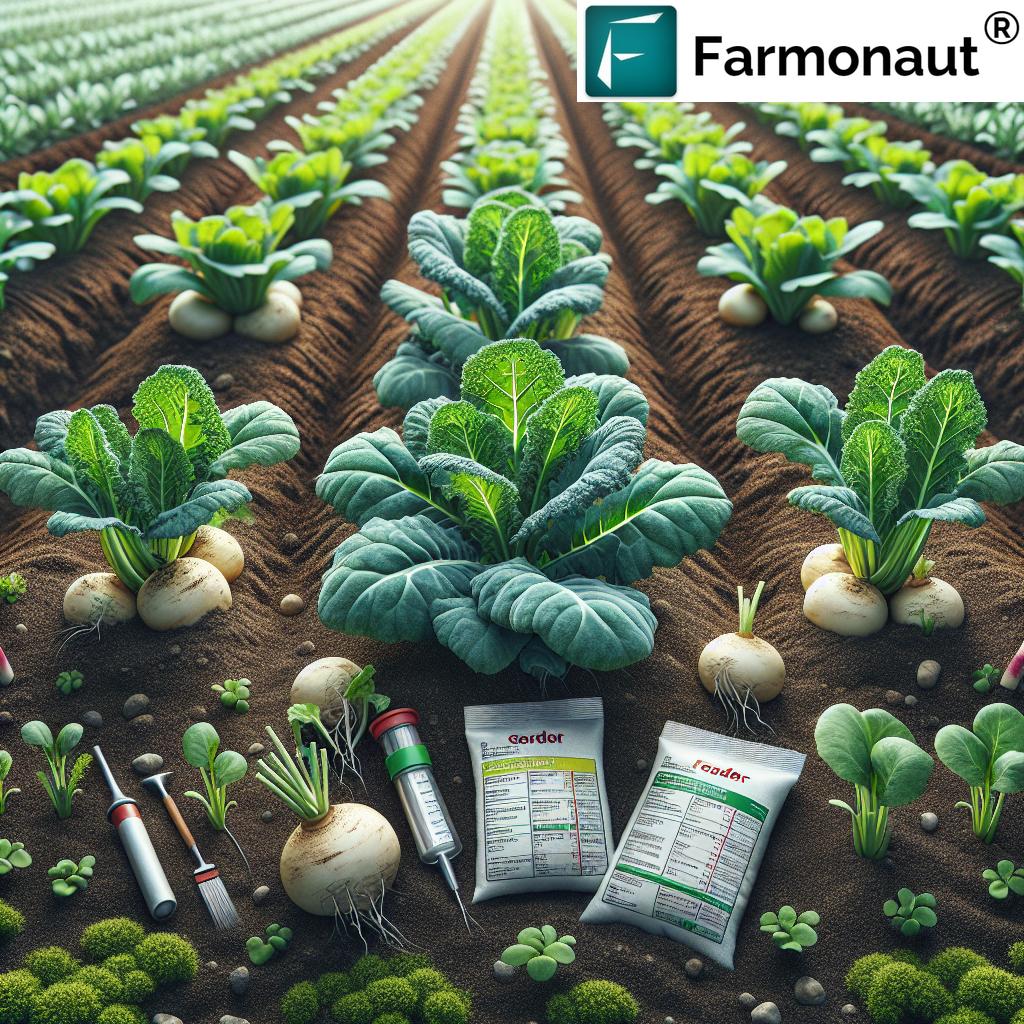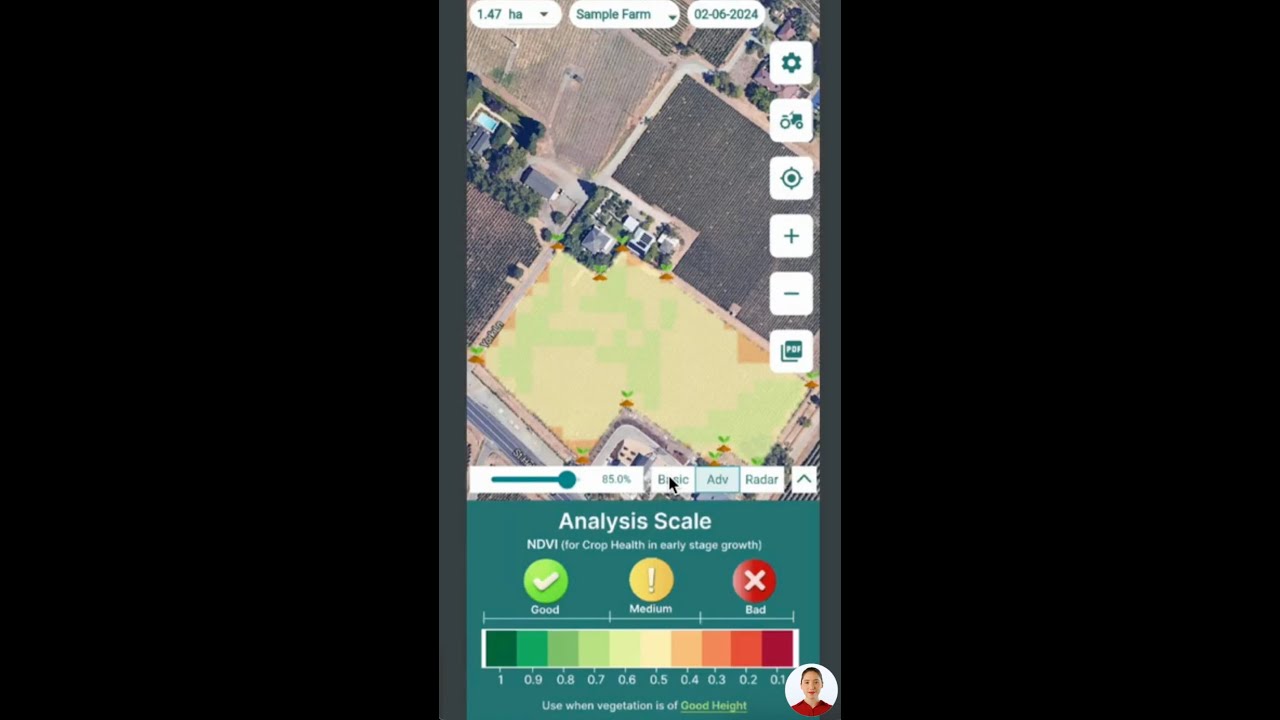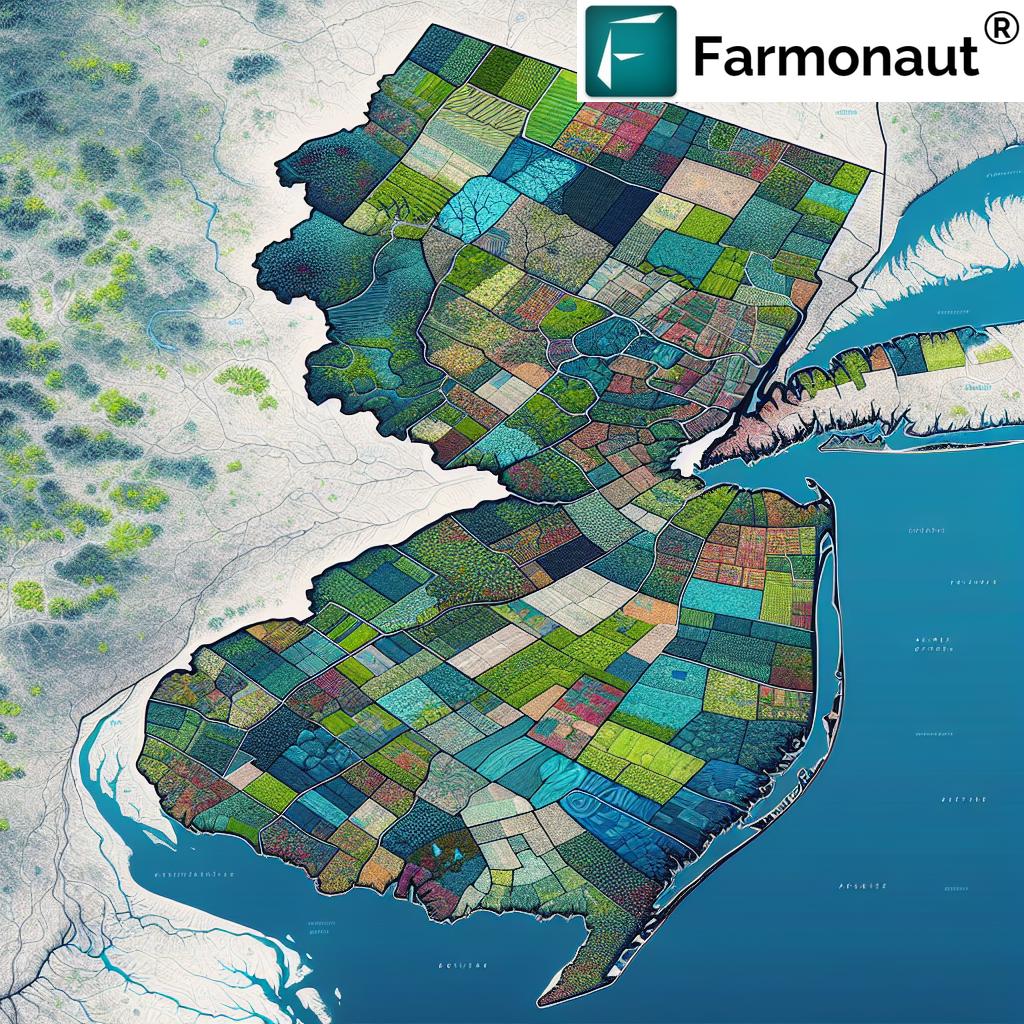Spring Greens Planting Guide: 7 Expert Tips for Arkansas Success
“Optimal seeding rate for spring greens in Arkansas is 1-2 pounds per 1,000 square feet for best yields.”
Table of Contents
- Introduction
- Popular Spring Green Varieties in Arkansas
- 1. Choose the Right Planting Dates and Monitor Temperatures
- 2. Understand the Best Soil for Greens
- 3. Soil Testing for Vegetable Crops in Arkansas
- 4. Address Soil Compaction Issues
- 5. Consider Field History, Herbicide Use & Weed Control for Spring Greens
- 6. Understand Optimal Seeding Rates & Seeding Methods
- 7. Know Fertilizer Requirements for Greens
- Spring Greens Planting Requirements Comparison Table
- Advanced Monitoring: Farmonaut Solutions for Spring Greens
- How to Harvest Spring Greens Effectively
- FAQs: Planting Spring Greens in Arkansas
- Conclusion
Introduction
Are we ready for a robust spring greens planting season in Arkansas? As producers eye opportunities to start their crops in March and April, understanding the essentials of soil, seeding, and weed control can make the difference between ordinary and outstanding yields. The University of Arkansas at Pine Bluff recommends starting when temperatures are reliably between 28° and 80°F for the next 7–10 weeks—making the period following the last expected winter freeze the best date for seeding these vibrant crops.
In this extensive planting guide, we’ll walk through 7 expert tips—from soil choice and field preparation to fertilizer requirements and harvest strategies—specifically tailored for Arkansas, with insights from Van Banks, Extension Associate for the University of Arkansas at Pine Bluff’s Small Farm Program. Along the way, we’ll show how leading-edge tools, like Farmonaut, can empower even small-scale farmers to maximize efficiency through precision and real-time management.
Popular Spring Green Varieties in Arkansas (Focus Keyword: “spring greens”)
Before jumping into the technical how-tos, let’s clarify what we mean by spring greens. For Arkansas growers, the main types are:
- Turnip Greens (Purple Top White Globe, Seven Top, Alltop)
- Mustard Greens (Florida Broadleaf, Southern Giant Curled)
- Collard Greens (Vates, Georgia Southern, Champion)
- Kale (Curly, Siberian, Lacinato)
These varieties are prized for their cold hardiness and versatility. They thrive when planted directly as seeds or, in the case of certain kale and collard types, as transplants for an earlier harvest. We’ll detail how to succeed with each, whether you are working sandy loam, silt loam, or raised beds.
1. Choose the Right Planting Dates and Monitor Temperatures
Timing is everything for planting spring greens. According to Banks at the University of Arkansas at Pine Bluff, the best date for planting is the week after the last expected winter freeze. For example, if the last freeze is anticipated around February 28, March 7 will be an ideal planting date for the first round of greens.
- The temperature range for germination is broadly 45°–95°F, with optimum results typically when daily highs stay between 28° and 80°F.
- Planning for 7–10 weeks of this favorable window ensures the tender leaves mature before the heat of summer.
- Use Farmonaut‘s satellite-based real-time temperature monitoring to facilitate the best timing for your spring crops.
By aligning your seeding with the right climate conditions, we give our plants the strongest start.
2. Understand the Best Soil for Greens
The best soil for greens in Arkansas is sandy loam or silt loam, thanks to their ability to allow internal drainage, preventing waterlogging while retaining enough moisture for steady growth.
- Sandy loam soil: Loose, easy to work, excellent for root development and quick drainage.
- Silt loam soil: Offers more water and nutrient holding capacity without the boggy feel of clay.
- If you have drainage issues, build up raised beds to further improve root health and crop yields.
It’s beneficial for producers to know their native soil type. Soil structure affects every aspect of plant growth, from germination and growth rate to nutrient uptake and ease of harvest.
“Spring greens thrive in soil with pH levels between 6.0 and 6.8 for maximum nutrient uptake.”
3. Soil Testing for Vegetable Crops in Arkansas
Determining the fertilizer requirements for greens relies on accurate soil testing for vegetable crops. This should be the first step for all producers aiming to optimize their yields and resource efficiency.
- Take a comprehensive soil test before planting to assess pH, organic matter, nitrogen (N), phosphorus (P), and potassium (K) levels.
- Not sure where to start? Contact your local county extension agent for detailed information and guidance on sampling and interpreting results.
- Adjust pH to 6.0–6.8 for optimal nutrient uptake for all spring greens.
Using Farmonaut’s platform for satellite-based field monitoring, we can complement soil test data with continuous crop health analysis—helping refine our inputs and improve yields.
Example:
If a soil test shows a nitrogen deficiency, apply a fertilizer blend (such as 10-10-10 N-P-K) suited for leafy greens at recommended rates, and split the application for best growth.
4. Address Soil Compaction Issues
Soil compaction is often an invisible barrier to success. When a plow pan or hard layer develops beneath the surface, roots cannot penetrate, and plants struggle to obtain water and nutrients. To ensure vigorous spring greens:
- Conduct a soil compaction test (with a penetrometer or probe) in any field being considered for planting.
- If a “hard pan” is found, deep tillage or subsoiling may be needed prior to planting.
- Avoid excessive traffic in wet conditions and rotate crops to reduce compaction risks.
Rectifying compaction increases root growth potential, affects the plant’s ability to obtain water and nutrients, and can significantly increase crop yields by improving nutrient uptake and drainage.
5. Consider Field History, Herbicide Use & Weed Control for Spring Greens
Know Your Field’s Herbicide and Weed History
Before we plant this season, let’s review:
-
Last year’s herbicide applications: Some residuals (types of herbicides applied) can linger and negatively affect the current crop.
- Confirm “replant interval” safety for your chosen varieties—especially if you’ve used pre-emergent or broadleaf weed killers recently.
- Field weed history: Make a list of perennial and annual weeds found last growing season.
-
Develop a proactive weed control for spring greens plan:
- Pre-emergence application: Apply Dual Magnum 7.62 EC at 0.67–1 pt/A for a single annual pass—ideal for controlling grasses and small-seeded weeds without harming your greens.
- Always comply with label rates and never use more than 1 pt/A or more than one application per year for this herbicide.
Well-planned herbicide use in vegetable fields means fewer surprises and higher yields at harvest.
- Monitor weed pressure post-emergence—physically scout or leverage Farmonaut’s NDVI and field health monitoring to identify new infestations early. This digital approach streamlines weed management and records field history for future planning.
6. Understand Optimal Seeding Rates & Seeding Methods: Direct Seeding vs Transplanting
Precise seeding rates and methods are vital for top performance when planting spring greens. Let’s break down the recommended approaches:
-
Turnip greens planting guide:
- Precision Planter: 1–2 pounds per acre (best uniformity and yield)
- Conventional Planter: 2–3 pounds per acre for turnips
-
Mustard and Collard Greens:
- Mustard greens: 3–4 pounds per acre by conventional planters
- Collards: 1–2 pounds per acre
- Kale: Can be direct-seeded or transplanted; transplants shorten the time to first harvest.
For smaller gardens or raised beds, the rule of thumb is 1–2 pounds per 1,000 sq. ft. Spread evenly, and keep the seedbed moist until germination.
When comparing direct seeding vs transplanting greens, note that:
- Direct seeded greens mature with a single main harvest; they are susceptible to weather and weed competition early on.
- Transplants (especially kale/collards) are usually ready for harvest 2–3 weeks sooner, with more uniform stand establishment.
Many of us grow in raised beds when spring soils are waterlogged—this keeps seedlings safe from root rot and supports vigorous growth.
7. Know Fertilizer Requirements for Greens
Nutrient demands for greens are high—especially for nitrogen, which powers leafy growth. Here’s how to get your fertility program right:
- Base all applications on soil testing for vegetable crops done prior to planting.
-
A common starting point for mustard, collard, turnip and kale is:
- Nitrogen: 60–120 lbs/acre, split between planting and early growth
- Phosphorus & Potassium: Add per soil test; a general guide is 50–90 lbs/acre each
- Use balanced, slow-release fertilizer for steady growth and avoid leaching.
Want to track nitrogen efficiency and fertilizer requirements for greens all season? The Farmonaut app provides satellite-based crop nutrition insight, optimizing timing and rates of applications.
For those pursuing sustainable, low-emission farming, Farmonaut’s carbon footprinting tools help monitor environmental impacts, aligning modern practices with compliance and climate goals.
Spring Greens Planting Requirements Comparison Table
| Crop Type | Recommended Planting Dates (Arkansas) | Soil Preparation Tips | Optimal Seeding Rate (lbs/acre) | Fertilizer Requirement (N-P-K) | Key Weed Control Strategies |
|---|---|---|---|---|---|
| Mustard Greens | March 7 – April 30 | Sandy/silt loam, well-drained pH: 6.0–6.8 |
1–2 (precision), 3–4 (conventional) | 80–100-80 | Dual Magnum 7.62 EC, mulch, shallow cultivation |
| Collard Greens | March 7 – April 15 (seed); Transplant: Late Feb – Mid March | Sandy loam, deep till pH: 6.5 |
1–2 (direct seed), 1 (transplants) | 80–100-90 | Dual Magnum, crop rotation, hand-weeding early |
| Turnip Greens | March 7 – April 15 | Silt loam, raised beds for wet soils | 1–2 (precision), 2–3 (conventional) | 60–90-80 | Pre-emergent herbicide, remove weeds pre-plant |
| Kale | March 7 – April 15 (seed/plant); Transplants: Feb end–March early | Sandy loam, compost mix | 1–1.5 (direct), 0.5–1 (transplant) | 90–110-100 | Mulching, Dual Magnum, hoe cultivation |
| Spinach | March 1 – April 10 | Fine sandy loam, pH: 6.5–7, pre-plant phosphorus |
10–15 | 60–90-80 | Shallow cultivation, poly mulch |
| Arugula | March 8 – April 20 | Loose sandy loam, organic matter rich | 5–7 | 45–60-45 | Pre-plant cleanout, row covers |
| Lettuce | March 5 – April 15 | Sandy silt loam, mulch, raised beds | 4–5 | 60–90-80 | Crop rotation, surface cultivation |
This table gives Arkansas farmers a side-by-side look at essential requirements for each popular spring green, including soil prep, seeding, fertilizer, and best weed control strategies. Bookmark it for quick reference each spring!
Advanced Monitoring: Farmonaut Solutions for Spring Greens
In today’s competitive landscape, using precision agriculture is no longer just an option—it’s our pathway to sustainability and profit. Farmonaut enables Arkansas producers to harness the power of satellite-based farm management, transforming everyday decision-making at the field level. Here’s how Farmonaut integrates with the spring greens cycle:
-
Real-time Crop Health Monitoring:
Multispectral satellite imagery (including NDVI) highlights areas of poor growth, soil moisture concerns, or hidden weed pressure. -
Jeevn AI Advisory System:
Personalized tips, weather updates, and diagnosis direct from your farm’s digital “dashboard.” -
Resource Allocation:
Know exactly when and where to apply fertilizer, irrigate, or scout for pests—minimizing waste and maximizing yields. -
Blockchain Traceability:
Provide buyers verifiable proof of crop origin, practices, and field-management history.
Learn more about Farmonaut Traceability Solutions >> -
Fleet & Resource Management:
Track movement of machines and field equipment to further lower costs.
Explore Farmonaut Fleet Management >> -
Large Scale & Aggregator Support:
Managers of multiple farms or larger tracts can monitor all fields from one centralized dashboard, identifying variability across townships, counties, or states.
Learn about Large Scale Farm Management >> -
API Access to Satellite Data:
Integrate Farmonaut’s satellite & weather data directly into your own system or see developer documentation.
All these features align perfectly with the changing regulatory environment and the push for eco-friendly, data-driven agriculture. Farmonaut is committed to making precision agriculture affordable for all.
How to Harvest Spring Greens Effectively
When spring greens approach market size, harvest practices influence both regrowth potential and final product quality. Here are the expert recommendations from Banks at Pine Bluff:
- Cut leaves 1 inch above the soil so new growth emerges for subsequent harvests.
- For single-cut crops, gently pull the entire plant for bunching and market prep.
- Bundle leaves in market-friendly sizes for transport and sale.
- Rapid cooling and hydro-cooling after harvest preserve quality.
Proper harvest technique is the last step in getting top yields and ensuring happy customers. Following up with a fresh application of fertilizer and washout of any broadleaf or annual weeds helps maintain beds for the next crop or regrowth.
FAQs: Planting Spring Greens in Arkansas
When is the best time to plant spring greens in Arkansas?
The ideal window is the week after the last expected winter freeze (e.g., after March 7) when daytime temperatures remain between 28 and 80°F for 7–10 weeks.
Which soil is best for greens?
Sandy loam and silt loam soils are ideal as they allow for internal drainage and unrestricted root growth. Adjust pH to 6.0–6.8 for best results.
What is the recommended seeding rate for turnip, mustard, and collard greens?
For precision planters: 1–2 pounds per acre; for conventional planters: 2–3 pounds (turnips) and 3–4 pounds (mustard).
Should I use transplants or direct seeding for spring greens?
Both are effective. Transplants (especially for kale and collards) can produce an earlier harvest, while direct seeding is simpler for larger fields.
How do I control weeds when planting spring greens?
Pre-emergence application of Dual Magnum 7.62 EC (0.67–1 pt/A, once per year) suppresses problem weeds. Maintain a field history to inform annual plans.
What are the fertilizer requirements for greens?
Apply 60–120 lbs/acre of nitrogen, based on soil testing, and recommended P and K amounts (often in the range of 80–100 lbs/acre). Adjust based on crop and soil conditions.
Where can I get help with advanced farming analytics or crop monitoring?
Try Farmonaut’s platform for real-time satellite data, crop health insights, and AI-driven advisory tools tailored to your field.
Conclusion
Planting spring greens in Arkansas demands more than just good timing—it is a blend of thoughtful soil preparation, precise seeding, vigilant weed control, and adaptive fertility management. Supported by tools like Farmonaut, we can transform our operations from guesswork to science-backed precision. By following the expert planting guide and leveraging data-driven technologies, all Arkansas producers—from family farm to large agribusiness—can set a solid foundation for high-yield, sustainable spring crops.
Whether it’s mustard and collard greens, turnip greens, or other leafy varieties, success starts with the soil and ends with the market basket. For regular updates, advisory, and further resources, download our app or explore more at Farmonaut.com.
Ready to elevate your spring crop operations? Try Farmonaut for affordable, effective, and sustainable precision farm management—all at your fingertips.






















